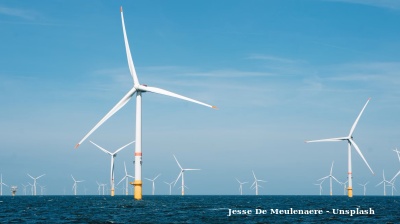As the global race for artificial intelligence (AI) supremacy accelerates, billions of dollars are flooding into AI infrastructure, spearheaded by technology giants such as Nvidia, Microsoft, Meta and Google. Central to this surge in investment is the production of AI chips – specialised semiconductors that are vital for training and operating advanced machine-learning models.
However, the meteoric rise of AI is sparking a parallel and largely overlooked environmental challenge: the significant climate impact of chip manufacturing, particularly in East Asia, says a new report from Greenpeace.
While considerable attention has been paid to the carbon footprint of data centres powering AI, the manufacturing process of AI-specific chips remains a blind spot in the sustainability debate, said the report. These chips, primarily advanced graphics processing units (GPUs), are mostly produced in Taiwan, South Korea, and Japan – regions heavily reliant on fossil fuels for electricity generation.
At the heart of global AI chip production is Taiwan Semiconductor Manufacturing Company (TSMC), which dominates the logic chip market with its high-performance fabrication plants – or "fabs" – located in Taiwan.
Meanwhile, memory chips essential to AI hardware are supplied by SK hynix, Samsung, and Micron, with operations centred in South Korea and Japan.
Electricity grids in these nations are still largely powered by fossil fuels. In 2023, South Korea derived 58.5% of its electricity from fossil sources, Japan 68.6%, and Taiwan a staggering 83.1%. As demand for AI hardware surges, so too does the pressure on these grids, threatening to deepen reliance on high-emissions energy sources.
In response to mounting demand, governments in the region are planning significant expansions in fossil fuel infrastructure.
In 2024, South Korea approved a 1-GW liquefied natural gas (LNG) combined heat and power plant for SK hynix, and is also backing the construction of 3 GW of LNG capacity for Samsung’s operations. These projects, once operational, are expected to exacerbate greenhouse gas (GHG) emissions and local air pollution – impacts that could be mitigated if the energy instead came from renewable sources, said the report.
Key chip models
New research has begun to quantify the environmental toll of AI chip manufacturing by examining the electricity consumption and associated emissions of key chip models, including Nvidia’s A100, H100, H200 and B100/200, and AMD’s MI300X.
Using a bottom-up approach, the study draws from public data, market forecasts, and production energy requirements to estimate the sector’s carbon footprint from 2023 out to 2030.
The findings are stark. Electricity use for AI chip manufacturing soared more than 350% year on year – from 218 GWh in 2023 to nearly 984 GWh in 2024. This steep rise is expected to continue. By 2030, the sector’s global electricity demand could reach 37,238 GWh – 170 times the 2023 level – surpassing the total electricity consumption of Ireland.
Taiwan has experienced the most dramatic increases. In 2024, AI chip production there consumed 375.8 GWh, equivalent to the annual usage of roughly 93,000 households – a 350% y/y jump. Projections suggest that the island’s overall electricity usage will rise by up to 13% by 2030, driven in large part by its booming semiconductor industry.
South Korea is not far behind. Power consumption from AI chip production more than doubled between 2023 and 2024, rising from 134.6 GWh to 315.2 GWh. By 2050, the Yongin area – home to a dense cluster of semiconductor facilities – could require over 10 GW of power, or 25% of the total electricity demand in the Seoul metropolitan region.
Global emissions
This surge in energy use is having a marked effect on emissions. Global emissions from electricity used in AI chipmaking grew over fourfold in just one year, climbing from 99,200 tonnes of CO₂ equivalent in 2023 to 453,600 tonnes in 2024.
In Taiwan, emissions ballooned from 41,200 tonnes in 2023 to 185,700 tonnes in 2024. South Korea’s chipmaking-related emissions more than doubled, from 58,000 to 135,900 tonnes. Japan, where memory chip production is also significant, saw emissions reach 132,100 tonnes in 2024.
Amid this alarming growth, some industry leaders and government officials are promoting fossil fuel and nuclear energy expansions as necessary solutions. In Taiwan, proposals are underway to convert existing oil units into high-capacity LNG turbines at Keelung Port, ostensibly to support AI development. Nvidia’s plans to open its regional headquarters in northern Taiwan have been cited to justify such projects, while Pegatron Corp’s chairman has publicly called for greater investment in nuclear power.
Critics argue this path risks locking in emissions for decades and undermining global climate goals. The urgency of addressing AI chipmaking's environmental impact is clear: without decisive intervention, its electricity consumption and carbon footprint will continue to balloon, says Greenpeace.
To align with global net-zero targets, the research recommends that major tech firms – Nvidia, Microsoft, Meta and Google – commit to sourcing 100% renewable electricity across their supply chains by 2030. These companies must also work closely with suppliers to facilitate clean energy procurement and carbon reduction strategies.
Chipmakers, particularly in East Asia, must follow suit by setting ambitious renewable energy targets and adopting high-impact sourcing strategies. This includes investing directly in renewable energy projects and entering into long-term power purchase agreements (PPAs) to secure clean electricity.
The future of AI doesn’t just hinge on faster processors and smarter algorithms – it also depends on sustainable, decarbonised production. As the industry propels forward, balancing innovation with responsibility is not optional; it is essential, concluded the report.
bneGREEN

The Arctic and Antarctica record "off the charts" heat as polar warming accelerates
Parts of both the Arctic and Antarctic have experienced historically high temperatures in recent weeks, with weather stations in East Antarctica recording record-breaking warmth for the month of October, alarming climate scientists.

Giant glacier chunk breaks away in Tajikistan, mountain villages put on alert
Situation serves as reminder that climate crisis threatens to wreak havoc in Central Asian country.

Singapore’s green pivot – headline grabbing but still limited
Forays into offshore wind via regional cooperation with neighbours, and forward-looking bets on hydrogen and low-carbon fuels are making headlines, but the scale required to wean a heavily gas-dependent system off fossil fuels is still daunting.

North Macedonia's Skopje tackles mounting waste and rodent crisis
Locals say the problems in Skopje's Centar municipality worsened during the local election period when political campaigning took precedence over maintenance.

_Cropped.jpg)


